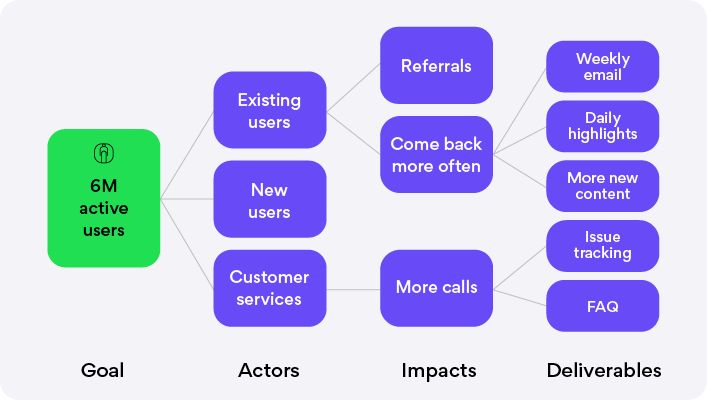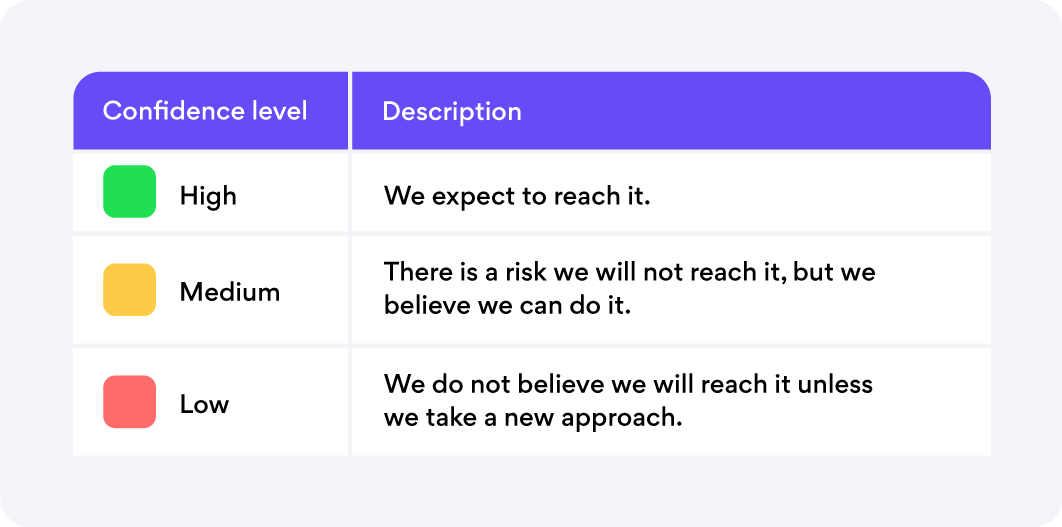
How to set up OKRs in your startup for maximum impact
April 27, 2023•9 mins read
OKRs give your startup more. More transparency and autonomy. More accountability and trust. A more engaged team and more meaningful KPIs. And, best of all, more ambitious goals.
This objective management framework is a perfect fit for the growth-focused Tesonet ecosystem. And one member of our community who has a long track record working with OKRs, and a huge wealth of knowledge to share, is Regimantas Urbanas, Surfshark’s Marketing head and recently crowned Lithuanian CMO of the year.
With over a decade of experience working with OKRs, Regimantas fully understands the value they can bring to startups. “They are not a nice side activity next to your day-to-day activities,” he explains. “This is the essence and focus of your startup, and everybody should be dedicated to OKRs and using them as effectively as possible.”
Regimantas took time to share with us some OKR best practices. So, whether you’re already using OKRs in your startup and are keen to optimize their effectiveness, or you’re considering introducing them, read on.
What exactly are OKRs?
No doubt you’re already familiar with the overall idea of OKRs, but here’s Regimantas with a quick rundown just in case.
“OKR stands for Objective and Key Results,” he explains. “It is an objective management framework that was established at Intel in the 1970s and has two overall focuses – to give people direction (by defining a specific goal) and to provide a means of measuring progress.”
“Before OKRs, there were a number of frameworks around – MBO, S.M.A.R.T, BSC,” Regimantas continues. “Since Google first adopted OKRs in 1999, it has gained traction and there was a steep uptick in the use of OKRs beginning in around 2018.”
Best practices to maximize the effectiveness of OKRs
Today, OKRs are a fixture in the startup world, and are used across Tesonet’s ecosystem. That’s because this framework helps startups in four important ways, says Regimantas.
- “OKRs supports empowerment and focus within the team. Your team members can prioritize more easily, and feel empowered because they get full autonomy on how to reach their goals.”
- “You also get better performance management. KPIs are more meaningful, you can evaluate performance objectively, and there is clear accountability.”
- “There is more transparency and better cooperation within your startup. Each team member understands the company’s goals, and how their actions are connected to them.”
- “Finally, this is a framework that really pushes startups forward. It makes you set up ambitious goals and shoot for the stars.”
Drawing from his 12 years’ of experience using OKRs at Google, Surfshark and a number of other startups and media companies, Regimantas believes there are a number of best practices startups can follow in order to get the maximum benefit from OKRs.
OKR best practice 1: Asking the right questions when creating Objectives
For OKRs to work for your startup, you need to dedicate time and energy to formulating good objectives.
First, figure out what your company goals are. “At this stage, it can be hard to set the right level of ambition,” says Regimantas. “So you need context. Understand your current situation by digging into your historical data and track record. And remember that it is OK to let yourself fail during your first attempt and then learn from your mistakes.”
“When defining your startup’s objectives, it can help to think of 3 specific areas – what you are trying to accomplish, what possibilities you have to get there, and which of these possibilities will have the biggest impact.”
OKR best practice 2: Mapping the impact
One of the keys to successful long-term use of OKRs is the ability to consistently identify the right Objectives to aim for, and then the right Key Results to measure these objectives.
“Impact mapping is a really helpful tool for this,” explains Regimantas. “It is a process that helps you figure out the different options you have for reaching your goal.”

“My main advice is to use impact mapping to help you identify the lower effort / highest impact objectives,” says Regimantas. “You should avoid objectives that are too challenging, and also look out for ones that are not challenging enough. I also think it is important not to set too many Objectives and Key Results right off the bat. Be selective and use impact mapping to help you prioritize.”
OKR best practice 3: Communicating the big picture
One of the most important benefits of OKRs is their ability to align your team and get everyone working towards the same overall goal.
“To do this, it’s important to circulate the company-level OKRs within your team. Tell everyone exactly what your goals are for the company in a specific Quarter or year. Then the Key Results you define for the whole company can become Objectives for a specific team or person. And they get the autonomy to define their own Key Results that will meet those Objectives. And it can roll out like this however large or small your startup is.”
OKR best practice 4: Measuring the progress
Finally, you will need to think about how you measure progress once your OKRs are set.
“Get your team to revise and approve the OKRs at their level, and then start measuring them on a weekly/monthly basis,” advises Regimantas. “A useful practice we have implemented in Surfshark is to indicate confidence levels. So, next to each Key Result, the responsible person shows how confident they are in that Key Result being achieved – at Surfshark, we use a simple red, amber, green scale.”

“This means that at any point, you can get an instant picture of what progress you are making towards each Key Result and, by extension, towards each Objective.”
“Then naturally, you need to set up weekly and monthly catch ups where you review the situation – you can then make adjustments in terms of resources or focus.”
Expert tips on how to formulate strong OKRs
So you have an overall picture of how to use OKRs in your startup, from asking the right questions to mapping impact and measuring results.
One skill that will be super important is being able to formulate strong OKRs. So, here are Regimantas’ expert tips on how to do this.
Pro tips – formulating a strong Objective
The Objective defines WHAT you want to achieve.
- A strong Objective needs to be action oriented, and should feel important and concrete.
- You want to find that edge where it is uncomfortably excited, without being unattainable.
- Your Objective does not have to be measurable (although it can be), but it must be strategic.
- Limit yourself to 3 per Quarter – any more and you will lose focus.
And use your 5-point checklist to evaluate each Objective you set:
- “Does the objective help us achieve our company goals?”
- “Is it inspiring?”
- “Does it move the company forward?”
- “Is it time bound?”
- “Will it be measured annually or quarterly?”
Pro tips – formulating strong Key Results
The Key Results define HOW you know you’re on track to achieve your Objective.
- Focus on outputs, rather than inputs. Instead of setting the Key Result “Make 10 sales calls” (input-based), make it “Secure 3 qualified leads” (output-based). You can spend lots of time and resources on input-based goals but they might lead to nothing, so focus on outputs.
- A strong Key Result must be specific and measurable.
- It should be directly connected to achieving the Objective.
- It needs to be quantifiable so you can measure success impartially.
- Limit yourself to 4 Key Results per Objective.
For each Key Result, you need to define what changes, by how much it will change, and by when
An example of effectively defined OKRs
“A nice example of an effective Objective for an early stage startup could be:
Launch an awesome MVP this year.
This objective will clearly help the startup achieve their goals and move them forward, plus it’s inspiring and timebound.”
“Then with your Key Results you can unpack what would represent meeting that goal – in other words, achieving the launch and ensuring the MVP is “awesome.” So you could have Key Results like:
- 40% of users come back two times in one week;
- A recommendation score of 8;
- A 15% conversion rate;
- 10,000 monthly visitors;
- and 5 mentions in the press.”
“You can see that these Key Results effectively define what a successful launch looks like, and help us judge if the MVP is truly ‘awesome’. They are also all output-based – they focus on an outcome rather than what we will do.”
Final tips on introducing OKRs
To wrap up, Regimantas has some handy advice for anyone planning to introduce OKRs into their startup – after all, he has introduced this framework at a number of the organizations he has worked at.
“In my experience, for most of your team introducing OKRs will come as a relief to your team, because individuals will understand how their work contributes to the overall goal,” says Regimantas.
“The only time you might get some resistance is if the ambitions are unrealistic. And this is an important issue to address. If on Day 1 your team doesn’t believe that the objectives you set can be reached, you won’t succeed.”
And one final piece of reassurance from Regimantas is that there are lots of success stories you can get inspiration from. “Businesses around the world are more alike than different, and you should remember that you are not alone. Many companies have implemented OKRs in a wide range of sectors, so Google it – you’ll find a lot of great examples that will inspire and guide your own journey.”
Read more like this
-
Business
May 22, 2025•4 mins read
Tesonet launches initiative to bring AI tools to schools in Lithuania
-
Business
March 12, 2025•2 mins read
Tesonet Plans to Build New Basketball Arena in London
-
Business
February 27, 2025•2 mins read
Tesonet Foundation Launch: Not Just Charity—Strategy
-
Business
March 14, 2024•6 mins read
Finding your focus - North Star Metrics in B2B marketing analytics







